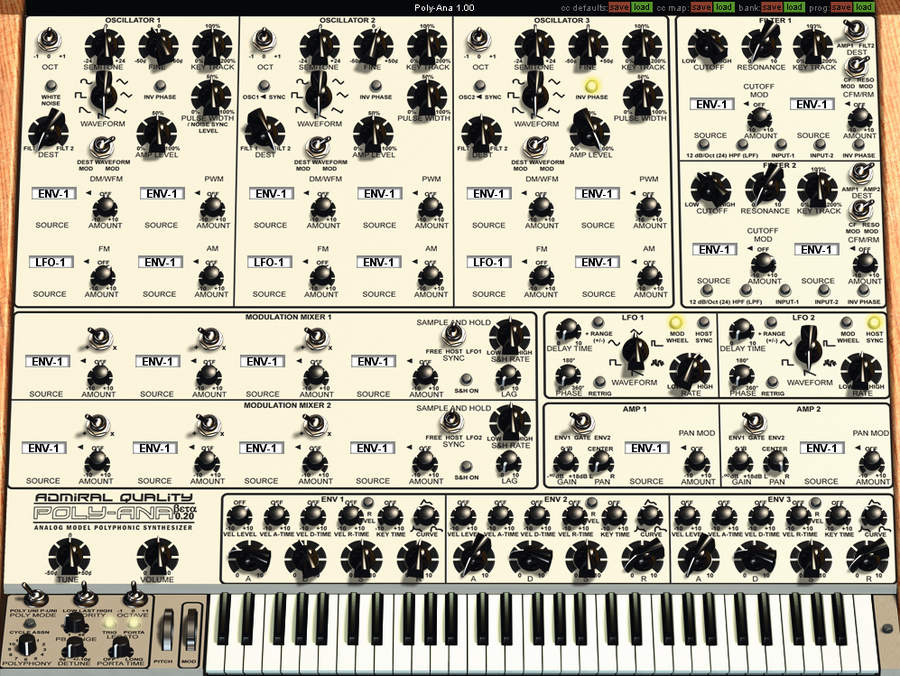MusicRadar Verdict
We were promised a brutish analogue synth, and that's exactly what Admiral Quality has given us. Poly-Ana doesn't really offer anything new, but it rips and snorts just like it should.
Pros
- +
Fantastic sound! Deep and complete architecture. Dual discrete signal paths. MIDI control galore. Elaborate envelopes.
Cons
- -
The GUI is a bit of a strain on the eyes. Only shows up as an effect in Cubase 4.
MusicRadar's got your back

Poly-Ana is as analogue as they come!

It comes with a choice of different 'skins'.
As its name suggests, Poly-Ana is yet another attempt to model that most popular of subjects, the vintage analogue synthesizer. While some of you will, quite understandably, be asking if we actually need another retro remake, you can rest assured that there are lots of musicians who believe that truly convincing software analogue synths remain few and far between.
Predictably, Admiral Quality is claiming that Poly-Ana is as analogue as they come. Sort of. Refreshingly, they're actually willing to admit that their new synth sounds best within a certain (but very wide) note range, and sure enough, there is some audible aliasing towards the top of the keyboard.
However, the developers also say that this is an inherent limitation caused by certain design choices that have resulted in a better overall sound within the optimum range. Basically, they're gambling that users won't mind this trade-off.
Overview
Poly-Ana is a Windows-only VSTi that has a familiar feature-set. There's a trio of analogue-style oscillators, a couple of filters and LFOs and three ADSR envelopes per voice. Such a signal path might usually elicit a yawn, but Poly-Ana is a labour of love for developers dead-set on creating the ultimate analogue virtual instrument.
Take the oscillators, for example: these don't simply spit out a handful of static square, saw and sine waves. Instead, you're presented with eight waveforms that are selected using a free-spinning knob. This enables you to dial up waveforms that sit anywhere between pairs from the given eight.
Oscillator sync is supported, but oddly, you can use sync even with the noise generator. What's more, pulse width modulation is always available, no matter what sort of waveform you select. Nice!
Each oscillator can be routed to either of the two filters, and there are four modulation source knobs for each and every oscillator. These enable FM, AM, waveform morphing and more besides.
Want all the hottest music and gear news, reviews, deals, features and more, direct to your inbox? Sign up here.
It should be noted that Poly-Ana's dual filters are indicative of the true, discrete stereo signal path that operates throughout the instrument. It's quite possible to create two distinct sounds in the same patch - one on the right channel and one on the left - and there's also the potential for layering.
Each filter offers 12dB and 24dB modes and both high- and low-pass operation. You can run them in series or parallel. One of our favourite (and often overlooked) tricks is on offer in the form of modulatable resonance. You can modulate the cutoff, of course.
Additionally, there are a couple of dedicated mod mixers, each with syncable sample and hold functions. The LFOs, meanwhile, have six waveforms among the shapes on offer, along with delay time and phase.
Ostensibly of the four-stage variety, the envelopes possess extra oomph by way of velocity-controlled attack. After playing with Poly-Ana for a while, we've come to realise that Admiral Quality always intended this to be something of a 'dream' analogue.
Synths have always been defined by the little features that have set them apart - from the Prophet 5's poly-mod section to the Minimoog's third oscillator and overdriven filter - and Admiral Quality have crammed just about every cool function from the most revered classics into a single package, and all on one page too - no tabs here.
This makes the GUI a bit intimidating at first, but it gives Poly-Ana impressive levels of depth and power.
CPU usage
That said, the synth isn't without its problems. Poly-Ana isn't a CPU lightweight, and the manual is not yet complete. However, most users will never need to look at this: anyone with even a rudimentary knowledge of subtractive synthesis will be up and running in seconds.
As for the CPU… well, you can hear where every single drop of juice is going in the rich, textured sounds that are Poly-Ana's stock in trade. While a number of the presets are geared towards modern styles, there are just as many that could have been yanked out of any number of polysynths from the 80s.
With names like 'Go Ahead And…' and 'Little Red Chevette', you know what you're going to get before you play a note. And since they don't depend on built-in effects, the factory patches are refreshingly clear and dry.
One strange quirk is that, in Cubase 4, Poly-Ana only appears in the VST effects list. There is indeed an effects processing version (see the In through the out door boxout for more), but the main synth shouldn't really be here.
This isn't such a big deal - you can still route MIDI to Poly-Ana - but it does mean you can't fire it up using a Cubase 4 instrument track. We have to end by talking about the sound, though, which really is fantastic.
There are a lot of VAs out there, but Admiral Quality's has the advantage of offering stellar quality at a reasonable price. If you love your analogues, it would be a crime not to experience what it has to offer.
Computer Music magazine is the world’s best selling publication dedicated solely to making great music with your Mac or PC computer. Each issue it brings its lucky readers the best in cutting-edge tutorials, need-to-know, expert software reviews and even all the tools you actually need to make great music today, courtesy of our legendary CM Plugin Suite.
